












What parameters can we change in a slingshot setup, and what will the results be? This chapter answers the question. The graphs are real recoded data, collected with a shooting bench and a chronograph. Steel balls of varying sizes were used as ammunition.


What happens during a shot? First, you draw back the bands. The necessary energy to do so
is provided by your muscles. Some of that energy is stored inside the bands, the rest is
dissipated as heat.
When you release the bands, they start to contract again. Projectile, pouch and bands
are accelerated. The stored energy is distributed between said parts.
The heavier your ammunition is, the bigger will be its share from the overall energy. But
at the same time, your ammo will fly slower, making long-range shots much more difficult.
We also need to know that a given bandset, at the given parameters, has a maximum speed (the one
developed by shoting without a projectile in the pouch), and this maximum velocity cannot be
exceeded, no matter what type of ammo is used. The following data shows you how changes to your
band setup affect the velocity and energy when projectiles of different weight are used.
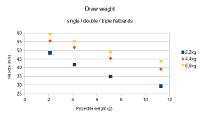
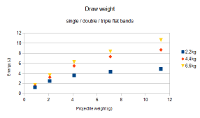
Let's assume you have two rubber bands: Rubber type, band length etc. ist exactly the same, but
band #2 is twice as wide, and thus has twice the drawing weight. You pull both of them back and let
them snap. What happens?
Both bands contract at the very same speed. The big band has twice the draw weight, but also has to
accelerate twice the mass.
Now take a look at the graph. You see three data from slingshots using single, double and triple layered bands of the same type. When lightweight ammo is used, you get a very small difference in velocity and energy. But the gap between them increases when the ammo weight increases. You can also see that the weakest bands are significantly slower, while the double and triple bands have a very similar velocity over the whole projectile weight range- in other words, the much higher pull weight from bandset #3 is useless unless very heavy projectiles are used, while bandset #1 already struggles to propel lightweight ammunition at an acceptable speed.
Conclusion 1: Strong bands profit from heavy ammunition.
Conclusion 2: Increasing a projectile's velocity by using heavier bands is only possible
to a limited extent. You quickly reach the point where adding band weight has very little effect.
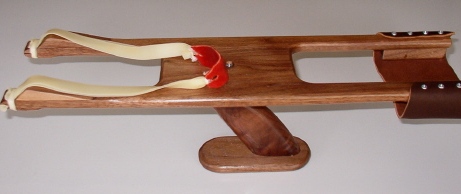
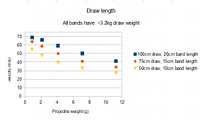
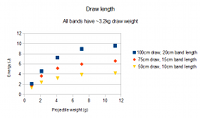
Conclusion: Draw length is king. Increasing it does increase both energy and
velocity, without the need for heavy ammo. There are two ways to add to your draw length:
First, you can pull the bands behind
our cheek. This type of shooting is called "Albatros style", or "Butterfly style". Once
you master this style, you'll be amazed about the velocities you can achieve, and the distance
you can hit targets. You'll also be amazed about the rate you have to change bands, as these
suffer from being accelerated so much.
The second method is to use a slingshot with extended forks, more info on these can be found in the
Addons section.
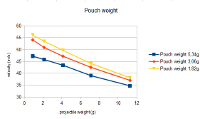
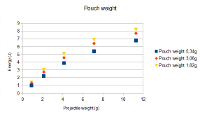
During the shot, the bands have to accelerate the combined weight of your projectile, the pouch and themselves. And the higher your pouch weight is, the more does it takes from overall energy. In reverse, you can diminish the (relative) amount of lost energy by using heavier bands or heavier ammunition.
Conclusion: Always try to keep the pouch weight on the light side. The heavier your ammo is, and the stronger your bands are, the less do you have to worry about it.

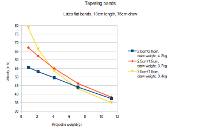
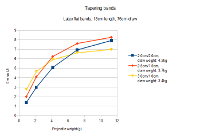
A tapered band gets thinner towards the pouch side. This has profound effects on its performance. Compared to an untapered band with the same rubber mass, you have less draw weight, but can shoot the projectile at a higher velocity! As a rule of thumb, you can say that the lighter your projectile and the stronger your bands are, the higher should your tapering ratio be. The downside of tapering is its negative effect on band life, though a light tapering (in the region of 2:3) does not affect it enough to worry about.
Conclusion: A mild tapering with a ratio of about 2:3 is always a good thing. More drastic tapering makes sense if you want to shoot relatively lightweight ammo with strong bands.
How long should your slingshots' bands be? This may be the most important question in choosing your band setup. The longer your bands are,
the less they have to extend (as long as you keep a constant draw length). Less extension means a much longer lifespan.
On the other hand, performance does dramatically increase with shorter bands. This is especially true if you want to shoot
lightweight ammunition at a high speed.
Typically, the band length - without the length needed for band attachment on fork and pouch - is between 18% and 25% of your draw length.
Longer bands will have a dramatically improved band life, with up to 2000 shots being not unusual. Shorter bands may live just a
few hundred shots, but will give you the velocity you may need for long-range shots or hunting. So choose wisely. That being said, if
you extend rubber bands to the absolute maximum, where you feel ythe bands cannot extend any longer, your velocity will actually decrease, and
your bands won't stand this torture for long.
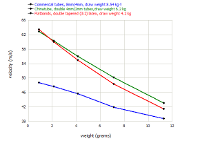
Different band shapes have a different performance. It is difficult to provide precise data on this subject, as the band's material is just as important, and one inevitable ends up comparing apples to oranges. What can be said, though, is that smaller, flexible bands with a higher surface generally have a better performance, especially with lightweight ammunition. Large tubular bands also seem to lack in performance, a possible explanation is that air is trapped inside the tubes, and causes trouble during the rapid. The graph shows three bands. One is a commercial untapered tubular band. The second one has dual small-diameter chinese-style tubular bands, while the third bandset has tapered flat bands. Please note that I'm audaciously comparing apples to oranges here, as the band have such a different draw weight, tapering, band material, and even a different extension ratio! I want to show you how much your slingshot's performance changes with different band setups.